Cloud Based Smart Application Management
VerifiedAdded on 2023/06/11
|12
|2960
|142
AI Summary
This article discusses the concept of cloud computing and its application in smart home management systems. It describes the functional and non-functional requirements of a cloud-based smart home management system and compares Amazon Web Services IoT and Digital Ocean PaaS. The article also explores the advantages and disadvantages of cloud computing and the challenges faced in implementing a working IoT application.
Contribute Materials
Your contribution can guide someone’s learning journey. Share your
documents today.
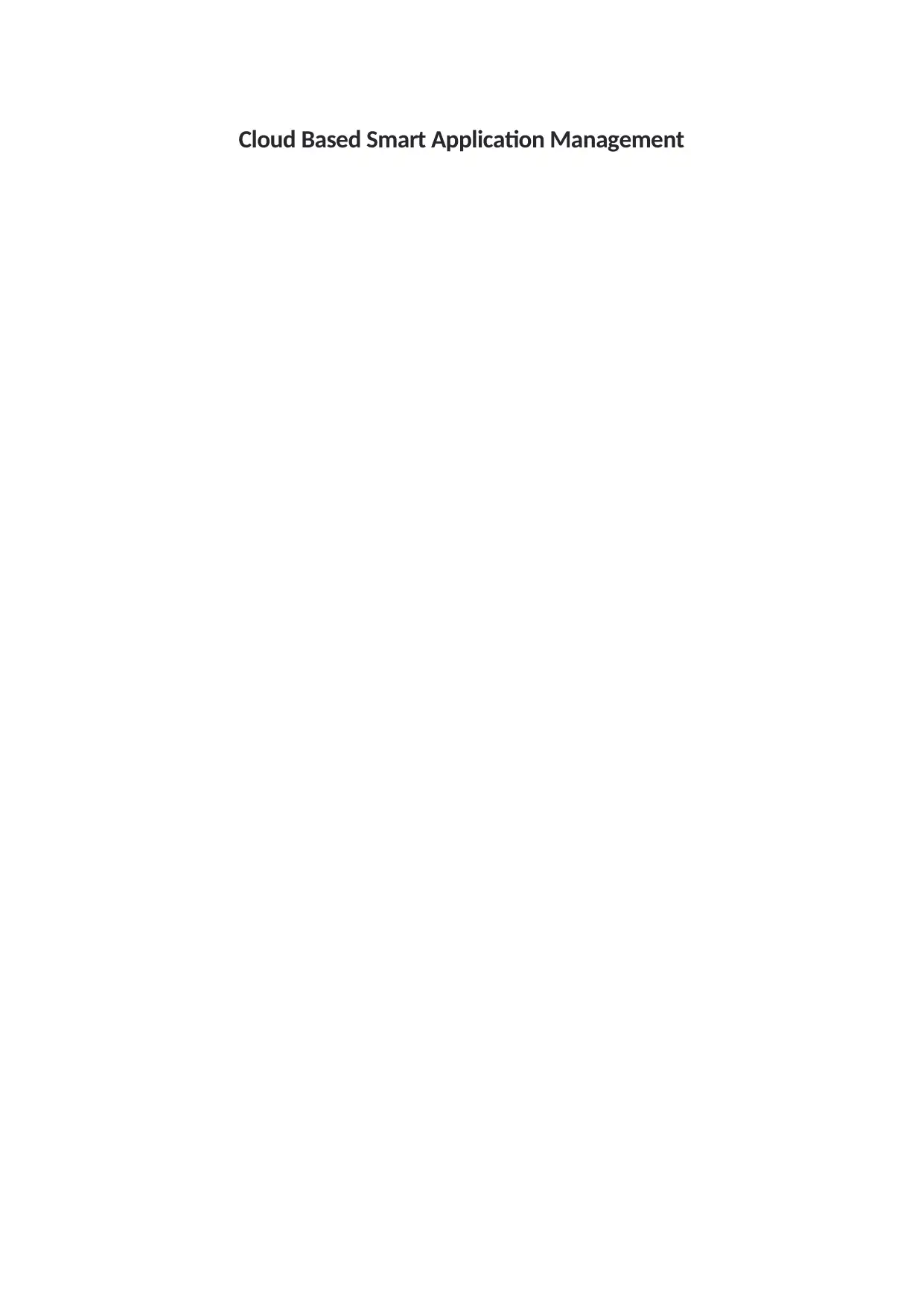
Cloud Based Smart Application Management
Secure Best Marks with AI Grader
Need help grading? Try our AI Grader for instant feedback on your assignments.

Table of Contents
Table of Contents................................................................................................2
Introduction to cloud computing.....................................................................3
Description of the application.........................................................................4
An Integrated Cloud-Based Smart Home Management System..................4
Functional and non-functional requirements...............................................5
Cloud service provider:....................................................................................6
Amazon Web Services (AWS).......................................................................6
Quality of design and navigation.....................................................................7
Challenges faced..............................................................................................7
Process of managing the resources.................................................................8
Support for zero downtime..............................................................................8
Advantages of Cloud computing......................................................................9
Disadvantages of Cloud computing.................................................................9
Analysis...............................................................................................................9
Comparison between Amazon Web Services IoT and Digital Ocean PaaS.....9
1. Range of Services....................................................................................9
2. Pricing.....................................................................................................9
3. Complexity...............................................................................................9
4. Support....................................................................................................9
5. Advanced Operations............................................................................10
Reasons of Preference...................................................................................10
Conclusion........................................................................................................11
References........................................................................................................12
Table of Contents................................................................................................2
Introduction to cloud computing.....................................................................3
Description of the application.........................................................................4
An Integrated Cloud-Based Smart Home Management System..................4
Functional and non-functional requirements...............................................5
Cloud service provider:....................................................................................6
Amazon Web Services (AWS).......................................................................6
Quality of design and navigation.....................................................................7
Challenges faced..............................................................................................7
Process of managing the resources.................................................................8
Support for zero downtime..............................................................................8
Advantages of Cloud computing......................................................................9
Disadvantages of Cloud computing.................................................................9
Analysis...............................................................................................................9
Comparison between Amazon Web Services IoT and Digital Ocean PaaS.....9
1. Range of Services....................................................................................9
2. Pricing.....................................................................................................9
3. Complexity...............................................................................................9
4. Support....................................................................................................9
5. Advanced Operations............................................................................10
Reasons of Preference...................................................................................10
Conclusion........................................................................................................11
References........................................................................................................12

Introduction to cloud computing
Cloud computing is a concept that came to revolutionize the technical operations of systems deployed on
the internet. If enables the provisioning of computing services through a network mostly the internet. It
attempts to eliminate the need for a physical computational resource into a remote provisioned resource.
In common terms, it eliminates the acquisition of irrelevant and unnecessary idle software and hardware
resource, it allows the renting of services and resources remotely through the pay as use model [1].
It is characterized by shared infrastructure which uses virtualization to manage the sharing of provisioned
resources among different subscribers. Moreover, it is based on dynamic provisioning which allows
allocation of services based on the demand requested. A critical aspect of cloud computing is the network
accessibility of the services across the internet all the time at any place.
Cloud computing has an architecture that allow different service models depending on the requirements of
the user. Software as a Service (SaaS) is a model where the consumers access and use a cloud-base
software application e.g. Office 365. Platform as a Service (PaaS) is another service model that the
consumers access a platform that is managed by the service provider but can deploy their own software
and applications e.g. Heroku. Infrastructure as a service (IaaS) is the last service model that allows the
subscribers to control and manage their provisioned environment in terms of the operating system,
storage, configurations and installations e.g. Digital Ocean.
The supported deployment models of cloud computing include a private cloud where the infrastructure is
maintained and operated for a particular organization according to their specific needs [2]. A community
cloud is a deployment model whereby the infrastructure is shared among a group of organizations with
similar requirements and needs. A public cloud is a public infrastructure open to everyone but have less
security strengths with little financial charges. And finally a hybrid cloud is composed of a number of
different deployment cloud models combined together.
Cloud computing is a concept that came to revolutionize the technical operations of systems deployed on
the internet. If enables the provisioning of computing services through a network mostly the internet. It
attempts to eliminate the need for a physical computational resource into a remote provisioned resource.
In common terms, it eliminates the acquisition of irrelevant and unnecessary idle software and hardware
resource, it allows the renting of services and resources remotely through the pay as use model [1].
It is characterized by shared infrastructure which uses virtualization to manage the sharing of provisioned
resources among different subscribers. Moreover, it is based on dynamic provisioning which allows
allocation of services based on the demand requested. A critical aspect of cloud computing is the network
accessibility of the services across the internet all the time at any place.
Cloud computing has an architecture that allow different service models depending on the requirements of
the user. Software as a Service (SaaS) is a model where the consumers access and use a cloud-base
software application e.g. Office 365. Platform as a Service (PaaS) is another service model that the
consumers access a platform that is managed by the service provider but can deploy their own software
and applications e.g. Heroku. Infrastructure as a service (IaaS) is the last service model that allows the
subscribers to control and manage their provisioned environment in terms of the operating system,
storage, configurations and installations e.g. Digital Ocean.
The supported deployment models of cloud computing include a private cloud where the infrastructure is
maintained and operated for a particular organization according to their specific needs [2]. A community
cloud is a deployment model whereby the infrastructure is shared among a group of organizations with
similar requirements and needs. A public cloud is a public infrastructure open to everyone but have less
security strengths with little financial charges. And finally a hybrid cloud is composed of a number of
different deployment cloud models combined together.
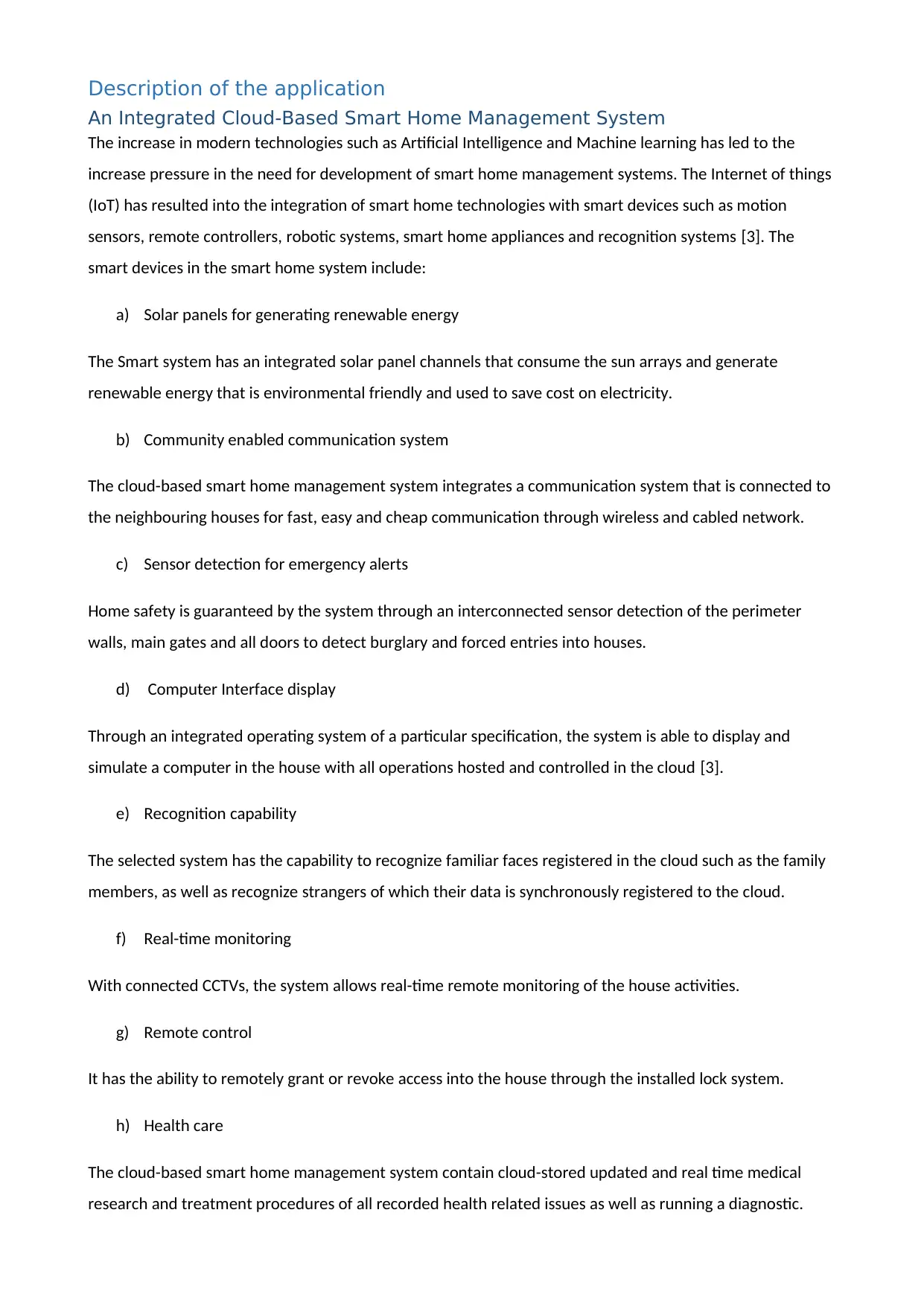
Description of the application
An Integrated Cloud-Based Smart Home Management System
The increase in modern technologies such as Artificial Intelligence and Machine learning has led to the
increase pressure in the need for development of smart home management systems. The Internet of things
(IoT) has resulted into the integration of smart home technologies with smart devices such as motion
sensors, remote controllers, robotic systems, smart home appliances and recognition systems [3]. The
smart devices in the smart home system include:
a) Solar panels for generating renewable energy
The Smart system has an integrated solar panel channels that consume the sun arrays and generate
renewable energy that is environmental friendly and used to save cost on electricity.
b) Community enabled communication system
The cloud-based smart home management system integrates a communication system that is connected to
the neighbouring houses for fast, easy and cheap communication through wireless and cabled network.
c) Sensor detection for emergency alerts
Home safety is guaranteed by the system through an interconnected sensor detection of the perimeter
walls, main gates and all doors to detect burglary and forced entries into houses.
d) Computer Interface display
Through an integrated operating system of a particular specification, the system is able to display and
simulate a computer in the house with all operations hosted and controlled in the cloud [3].
e) Recognition capability
The selected system has the capability to recognize familiar faces registered in the cloud such as the family
members, as well as recognize strangers of which their data is synchronously registered to the cloud.
f) Real-time monitoring
With connected CCTVs, the system allows real-time remote monitoring of the house activities.
g) Remote control
It has the ability to remotely grant or revoke access into the house through the installed lock system.
h) Health care
The cloud-based smart home management system contain cloud-stored updated and real time medical
research and treatment procedures of all recorded health related issues as well as running a diagnostic.
An Integrated Cloud-Based Smart Home Management System
The increase in modern technologies such as Artificial Intelligence and Machine learning has led to the
increase pressure in the need for development of smart home management systems. The Internet of things
(IoT) has resulted into the integration of smart home technologies with smart devices such as motion
sensors, remote controllers, robotic systems, smart home appliances and recognition systems [3]. The
smart devices in the smart home system include:
a) Solar panels for generating renewable energy
The Smart system has an integrated solar panel channels that consume the sun arrays and generate
renewable energy that is environmental friendly and used to save cost on electricity.
b) Community enabled communication system
The cloud-based smart home management system integrates a communication system that is connected to
the neighbouring houses for fast, easy and cheap communication through wireless and cabled network.
c) Sensor detection for emergency alerts
Home safety is guaranteed by the system through an interconnected sensor detection of the perimeter
walls, main gates and all doors to detect burglary and forced entries into houses.
d) Computer Interface display
Through an integrated operating system of a particular specification, the system is able to display and
simulate a computer in the house with all operations hosted and controlled in the cloud [3].
e) Recognition capability
The selected system has the capability to recognize familiar faces registered in the cloud such as the family
members, as well as recognize strangers of which their data is synchronously registered to the cloud.
f) Real-time monitoring
With connected CCTVs, the system allows real-time remote monitoring of the house activities.
g) Remote control
It has the ability to remotely grant or revoke access into the house through the installed lock system.
h) Health care
The cloud-based smart home management system contain cloud-stored updated and real time medical
research and treatment procedures of all recorded health related issues as well as running a diagnostic.
Secure Best Marks with AI Grader
Need help grading? Try our AI Grader for instant feedback on your assignments.
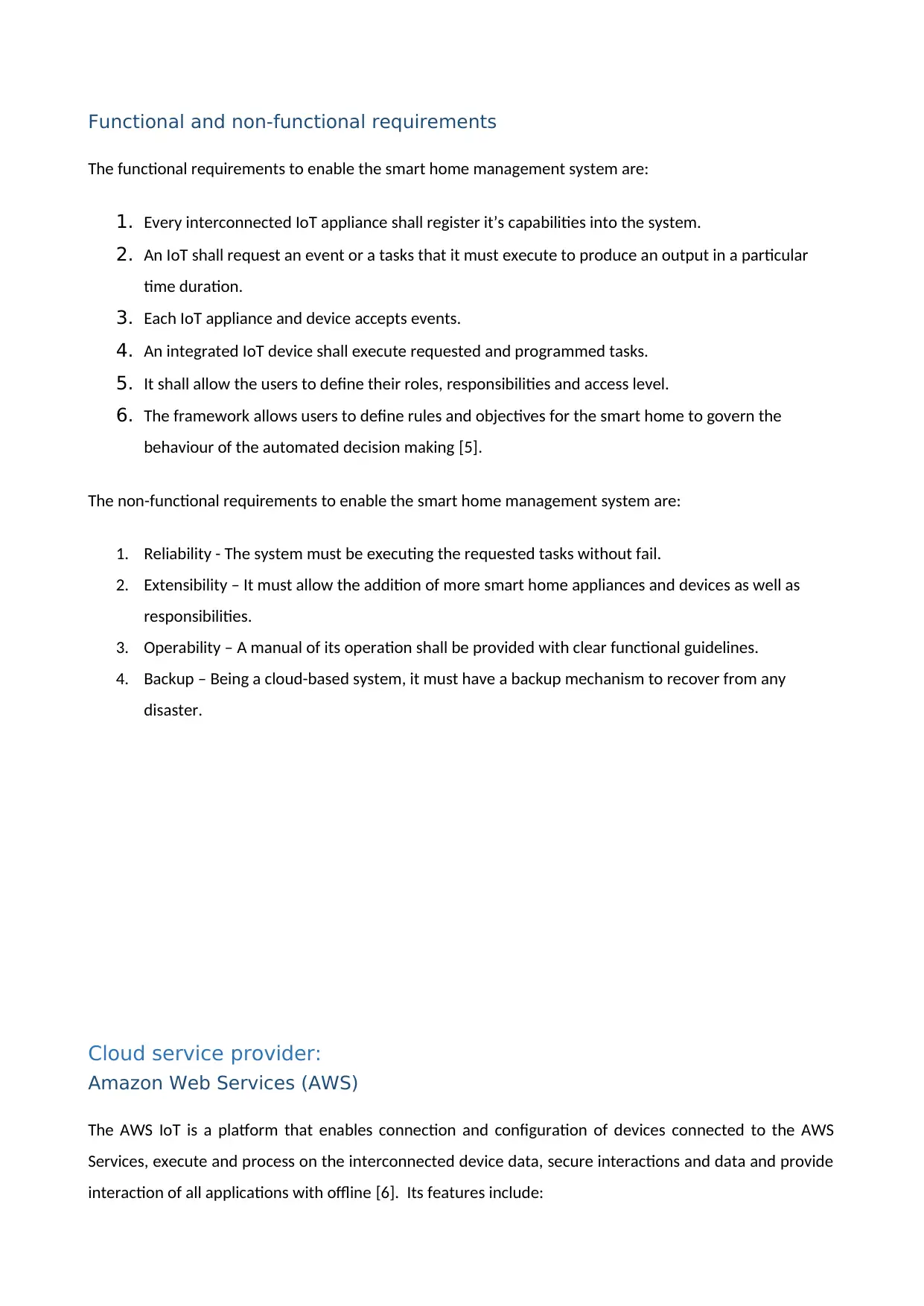
Functional and non-functional requirements
The functional requirements to enable the smart home management system are:
1. Every interconnected IoT appliance shall register it’s capabilities into the system.
2. An IoT shall request an event or a tasks that it must execute to produce an output in a particular
time duration.
3. Each IoT appliance and device accepts events.
4. An integrated IoT device shall execute requested and programmed tasks.
5. It shall allow the users to define their roles, responsibilities and access level.
6. The framework allows users to define rules and objectives for the smart home to govern the
behaviour of the automated decision making [5].
The non-functional requirements to enable the smart home management system are:
1. Reliability - The system must be executing the requested tasks without fail.
2. Extensibility – It must allow the addition of more smart home appliances and devices as well as
responsibilities.
3. Operability – A manual of its operation shall be provided with clear functional guidelines.
4. Backup – Being a cloud-based system, it must have a backup mechanism to recover from any
disaster.
Cloud service provider:
Amazon Web Services (AWS)
The AWS IoT is a platform that enables connection and configuration of devices connected to the AWS
Services, execute and process on the interconnected device data, secure interactions and data and provide
interaction of all applications with offline [6]. Its features include:
The functional requirements to enable the smart home management system are:
1. Every interconnected IoT appliance shall register it’s capabilities into the system.
2. An IoT shall request an event or a tasks that it must execute to produce an output in a particular
time duration.
3. Each IoT appliance and device accepts events.
4. An integrated IoT device shall execute requested and programmed tasks.
5. It shall allow the users to define their roles, responsibilities and access level.
6. The framework allows users to define rules and objectives for the smart home to govern the
behaviour of the automated decision making [5].
The non-functional requirements to enable the smart home management system are:
1. Reliability - The system must be executing the requested tasks without fail.
2. Extensibility – It must allow the addition of more smart home appliances and devices as well as
responsibilities.
3. Operability – A manual of its operation shall be provided with clear functional guidelines.
4. Backup – Being a cloud-based system, it must have a backup mechanism to recover from any
disaster.
Cloud service provider:
Amazon Web Services (AWS)
The AWS IoT is a platform that enables connection and configuration of devices connected to the AWS
Services, execute and process on the interconnected device data, secure interactions and data and provide
interaction of all applications with offline [6]. Its features include:

1. AWS IoT Device SDK
The Device SDK facilitates integrated devices to authenticate, connect, and exchange messages with AWS
IoT Core using the HTTP, MQTT, or WebSockets protocols.
2. Device Gateway
This is the gateway that serves as the entry point for IoT devices connecting to AWS. It implements
semantics for multiple protocols and manages all integrated device connections.
3. Message Broker
It is a high throughput sub message connector that securely transmits messages to and from all of
connected IoT devices and applications with low latency.
4. Authentication and Authorization
AWS IoT Core provides an encryption mechanism and a mutual authentication system and at all points of
connection, therefore, data can never be exchanged between AWS IoT Core and devices without a known
identity.
5. Registry
The Registry enables identification for devices and monitors metadata such as the devices’ capabilities and
attribute.
5. Rules Engine
The Rules Engine facilitates building of IoT applications that gather, process, analyse and execute on
generated data by integrated devices globally without the management of any infrastructure.
Quality of design and navigation
The AWS IoT platform contain a Management Console that is a management web application for the
Amazon Web Services. It is composed of a list of various available services and their information and
documentation of implementation.
The AWS IoT Management console has a visual design for a better improved usability and navigation of the
services. The visual representation enables easy location of the types, certificates, policies, rules and
components of the services.
The Device SDK facilitates integrated devices to authenticate, connect, and exchange messages with AWS
IoT Core using the HTTP, MQTT, or WebSockets protocols.
2. Device Gateway
This is the gateway that serves as the entry point for IoT devices connecting to AWS. It implements
semantics for multiple protocols and manages all integrated device connections.
3. Message Broker
It is a high throughput sub message connector that securely transmits messages to and from all of
connected IoT devices and applications with low latency.
4. Authentication and Authorization
AWS IoT Core provides an encryption mechanism and a mutual authentication system and at all points of
connection, therefore, data can never be exchanged between AWS IoT Core and devices without a known
identity.
5. Registry
The Registry enables identification for devices and monitors metadata such as the devices’ capabilities and
attribute.
5. Rules Engine
The Rules Engine facilitates building of IoT applications that gather, process, analyse and execute on
generated data by integrated devices globally without the management of any infrastructure.
Quality of design and navigation
The AWS IoT platform contain a Management Console that is a management web application for the
Amazon Web Services. It is composed of a list of various available services and their information and
documentation of implementation.
The AWS IoT Management console has a visual design for a better improved usability and navigation of the
services. The visual representation enables easy location of the types, certificates, policies, rules and
components of the services.
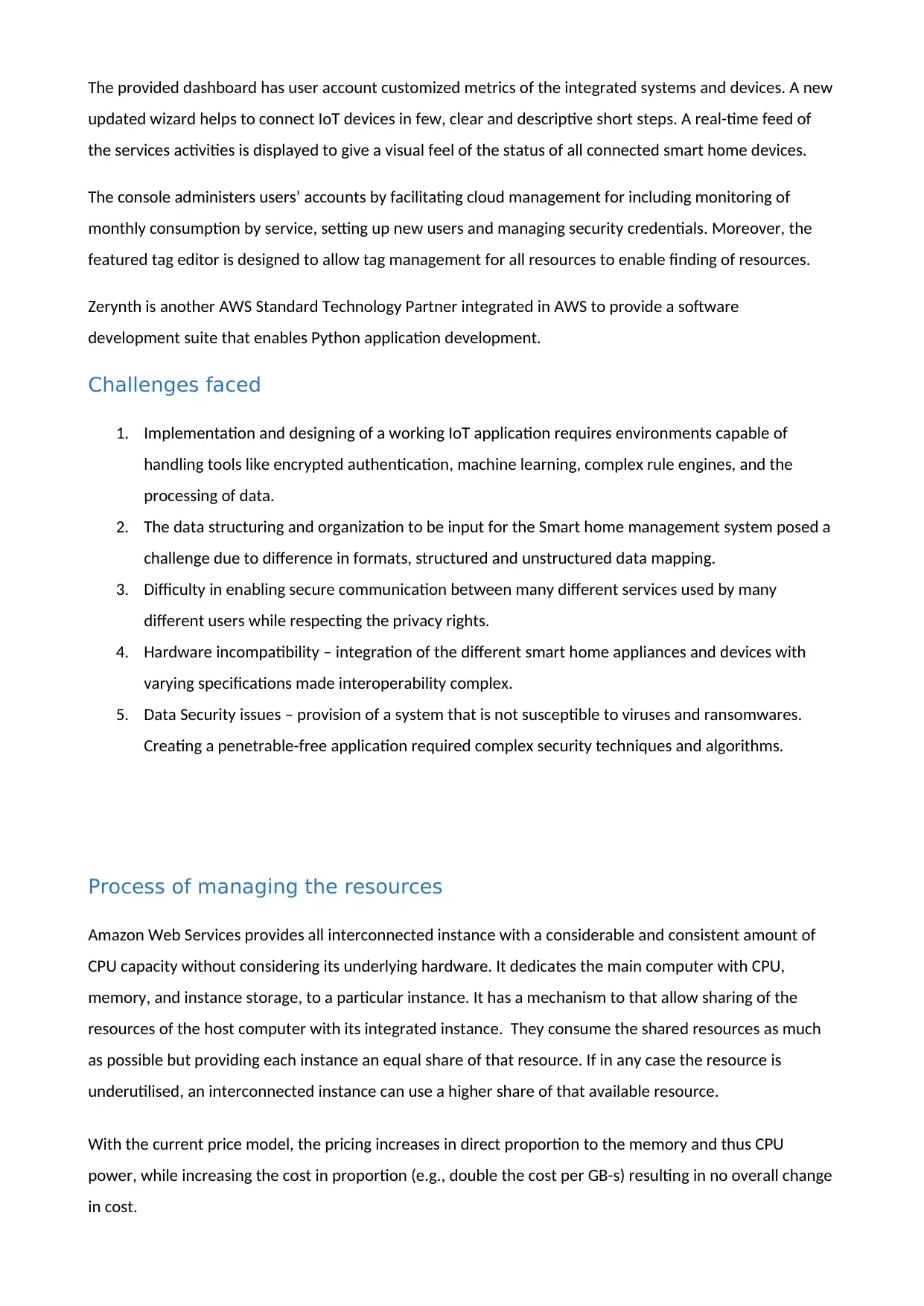
The provided dashboard has user account customized metrics of the integrated systems and devices. A new
updated wizard helps to connect IoT devices in few, clear and descriptive short steps. A real-time feed of
the services activities is displayed to give a visual feel of the status of all connected smart home devices.
The console administers users’ accounts by facilitating cloud management for including monitoring of
monthly consumption by service, setting up new users and managing security credentials. Moreover, the
featured tag editor is designed to allow tag management for all resources to enable finding of resources.
Zerynth is another AWS Standard Technology Partner integrated in AWS to provide a software
development suite that enables Python application development.
Challenges faced
1. Implementation and designing of a working IoT application requires environments capable of
handling tools like encrypted authentication, machine learning, complex rule engines, and the
processing of data.
2. The data structuring and organization to be input for the Smart home management system posed a
challenge due to difference in formats, structured and unstructured data mapping.
3. Difficulty in enabling secure communication between many different services used by many
different users while respecting the privacy rights.
4. Hardware incompatibility – integration of the different smart home appliances and devices with
varying specifications made interoperability complex.
5. Data Security issues – provision of a system that is not susceptible to viruses and ransomwares.
Creating a penetrable-free application required complex security techniques and algorithms.
Process of managing the resources
Amazon Web Services provides all interconnected instance with a considerable and consistent amount of
CPU capacity without considering its underlying hardware. It dedicates the main computer with CPU,
memory, and instance storage, to a particular instance. It has a mechanism to that allow sharing of the
resources of the host computer with its integrated instance. They consume the shared resources as much
as possible but providing each instance an equal share of that resource. If in any case the resource is
underutilised, an interconnected instance can use a higher share of that available resource.
With the current price model, the pricing increases in direct proportion to the memory and thus CPU
power, while increasing the cost in proportion (e.g., double the cost per GB-s) resulting in no overall change
in cost.
updated wizard helps to connect IoT devices in few, clear and descriptive short steps. A real-time feed of
the services activities is displayed to give a visual feel of the status of all connected smart home devices.
The console administers users’ accounts by facilitating cloud management for including monitoring of
monthly consumption by service, setting up new users and managing security credentials. Moreover, the
featured tag editor is designed to allow tag management for all resources to enable finding of resources.
Zerynth is another AWS Standard Technology Partner integrated in AWS to provide a software
development suite that enables Python application development.
Challenges faced
1. Implementation and designing of a working IoT application requires environments capable of
handling tools like encrypted authentication, machine learning, complex rule engines, and the
processing of data.
2. The data structuring and organization to be input for the Smart home management system posed a
challenge due to difference in formats, structured and unstructured data mapping.
3. Difficulty in enabling secure communication between many different services used by many
different users while respecting the privacy rights.
4. Hardware incompatibility – integration of the different smart home appliances and devices with
varying specifications made interoperability complex.
5. Data Security issues – provision of a system that is not susceptible to viruses and ransomwares.
Creating a penetrable-free application required complex security techniques and algorithms.
Process of managing the resources
Amazon Web Services provides all interconnected instance with a considerable and consistent amount of
CPU capacity without considering its underlying hardware. It dedicates the main computer with CPU,
memory, and instance storage, to a particular instance. It has a mechanism to that allow sharing of the
resources of the host computer with its integrated instance. They consume the shared resources as much
as possible but providing each instance an equal share of that resource. If in any case the resource is
underutilised, an interconnected instance can use a higher share of that available resource.
With the current price model, the pricing increases in direct proportion to the memory and thus CPU
power, while increasing the cost in proportion (e.g., double the cost per GB-s) resulting in no overall change
in cost.
Paraphrase This Document
Need a fresh take? Get an instant paraphrase of this document with our AI Paraphraser

Each Amazon Elastic Compute Cloud (Amazon EC2) instance comes with standardized CPUs, amounts of
RAM, and feature sets. It allows customized hardware configuration to change the current EC2 instance's
type. The current instance must be stopped and then restarted. Data back-up and storage in instance store
drives is also necessary to prevent data loss. Maintain backups of your instances and data as a best
practice.
Support for zero downtime
Amazon Web Services provides a Zero-Downtime patching feature that enables updating of the IoT
instances with no effect on availability and no downtime. It is configured to support both single node
clusters and multi-node clusters. The configuration on the patching mechanism pauses when waiting for
open active locks, pending transactions, temporary tables to clear up and SSL connections. The
preservation of application sessions is enabled and the database engine restarts simultaneously as the
patch is in progress, leading to a transient drop in throughput.
AWS CodeDeploy service automates code deployments to any instance making it easier to avoid downtime
during application deployment and handle the complexity of updating your applications.
The Elastic Load Balancer in the AWS IoT platform distributes evenly all incoming application traffic across
multiple EC2 instances. This capability enables the provision of operations at all times.
Advantages of Cloud computing
1. Data backup and restoration – data stored in the cloud is easier to get the backed-up and
recovered.
2. High Speed – It facilitates deployment of services quickly. This quick deployment lets you get the
resources required for your system within fewer minutes.
3. Accessibility – Storing the information in cloud allows you to access it anywhere, anytime
regardless of the machine making it highly accessible and flexible technology of present times.
Disadvantages of Cloud computing
1. Insecurity – Cloud computing can be vulnerable to attacks. Storing massive amount of data in cloud
may be susceptible to information theft.
2. Less control – All applications and systems on cloud services are deployed on remote servers which
makes it hard for the organizations to have complete control over the infrastructure.
RAM, and feature sets. It allows customized hardware configuration to change the current EC2 instance's
type. The current instance must be stopped and then restarted. Data back-up and storage in instance store
drives is also necessary to prevent data loss. Maintain backups of your instances and data as a best
practice.
Support for zero downtime
Amazon Web Services provides a Zero-Downtime patching feature that enables updating of the IoT
instances with no effect on availability and no downtime. It is configured to support both single node
clusters and multi-node clusters. The configuration on the patching mechanism pauses when waiting for
open active locks, pending transactions, temporary tables to clear up and SSL connections. The
preservation of application sessions is enabled and the database engine restarts simultaneously as the
patch is in progress, leading to a transient drop in throughput.
AWS CodeDeploy service automates code deployments to any instance making it easier to avoid downtime
during application deployment and handle the complexity of updating your applications.
The Elastic Load Balancer in the AWS IoT platform distributes evenly all incoming application traffic across
multiple EC2 instances. This capability enables the provision of operations at all times.
Advantages of Cloud computing
1. Data backup and restoration – data stored in the cloud is easier to get the backed-up and
recovered.
2. High Speed – It facilitates deployment of services quickly. This quick deployment lets you get the
resources required for your system within fewer minutes.
3. Accessibility – Storing the information in cloud allows you to access it anywhere, anytime
regardless of the machine making it highly accessible and flexible technology of present times.
Disadvantages of Cloud computing
1. Insecurity – Cloud computing can be vulnerable to attacks. Storing massive amount of data in cloud
may be susceptible to information theft.
2. Less control – All applications and systems on cloud services are deployed on remote servers which
makes it hard for the organizations to have complete control over the infrastructure.
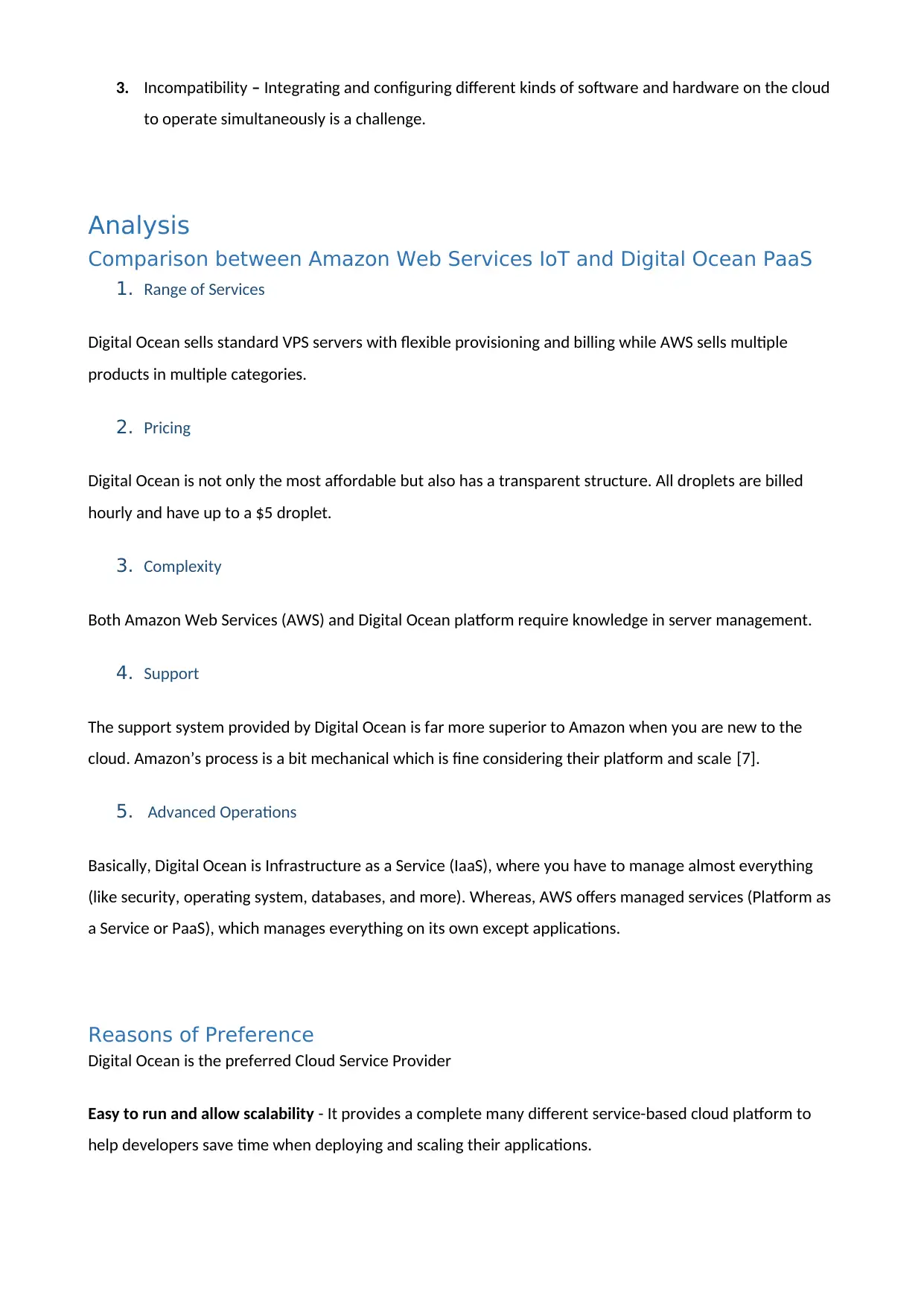
3. Incompatibility – Integrating and configuring different kinds of software and hardware on the cloud
to operate simultaneously is a challenge.
Analysis
Comparison between Amazon Web Services IoT and Digital Ocean PaaS
1. Range of Services
Digital Ocean sells standard VPS servers with flexible provisioning and billing while AWS sells multiple
products in multiple categories.
2. Pricing
Digital Ocean is not only the most affordable but also has a transparent structure. All droplets are billed
hourly and have up to a $5 droplet.
3. Complexity
Both Amazon Web Services (AWS) and Digital Ocean platform require knowledge in server management.
4. Support
The support system provided by Digital Ocean is far more superior to Amazon when you are new to the
cloud. Amazon’s process is a bit mechanical which is fine considering their platform and scale [7].
5. Advanced Operations
Basically, Digital Ocean is Infrastructure as a Service (IaaS), where you have to manage almost everything
(like security, operating system, databases, and more). Whereas, AWS offers managed services (Platform as
a Service or PaaS), which manages everything on its own except applications.
Reasons of Preference
Digital Ocean is the preferred Cloud Service Provider
Easy to run and allow scalability - It provides a complete many different service-based cloud platform to
help developers save time when deploying and scaling their applications.
to operate simultaneously is a challenge.
Analysis
Comparison between Amazon Web Services IoT and Digital Ocean PaaS
1. Range of Services
Digital Ocean sells standard VPS servers with flexible provisioning and billing while AWS sells multiple
products in multiple categories.
2. Pricing
Digital Ocean is not only the most affordable but also has a transparent structure. All droplets are billed
hourly and have up to a $5 droplet.
3. Complexity
Both Amazon Web Services (AWS) and Digital Ocean platform require knowledge in server management.
4. Support
The support system provided by Digital Ocean is far more superior to Amazon when you are new to the
cloud. Amazon’s process is a bit mechanical which is fine considering their platform and scale [7].
5. Advanced Operations
Basically, Digital Ocean is Infrastructure as a Service (IaaS), where you have to manage almost everything
(like security, operating system, databases, and more). Whereas, AWS offers managed services (Platform as
a Service or PaaS), which manages everything on its own except applications.
Reasons of Preference
Digital Ocean is the preferred Cloud Service Provider
Easy to run and allow scalability - It provides a complete many different service-based cloud platform to
help developers save time when deploying and scaling their applications.
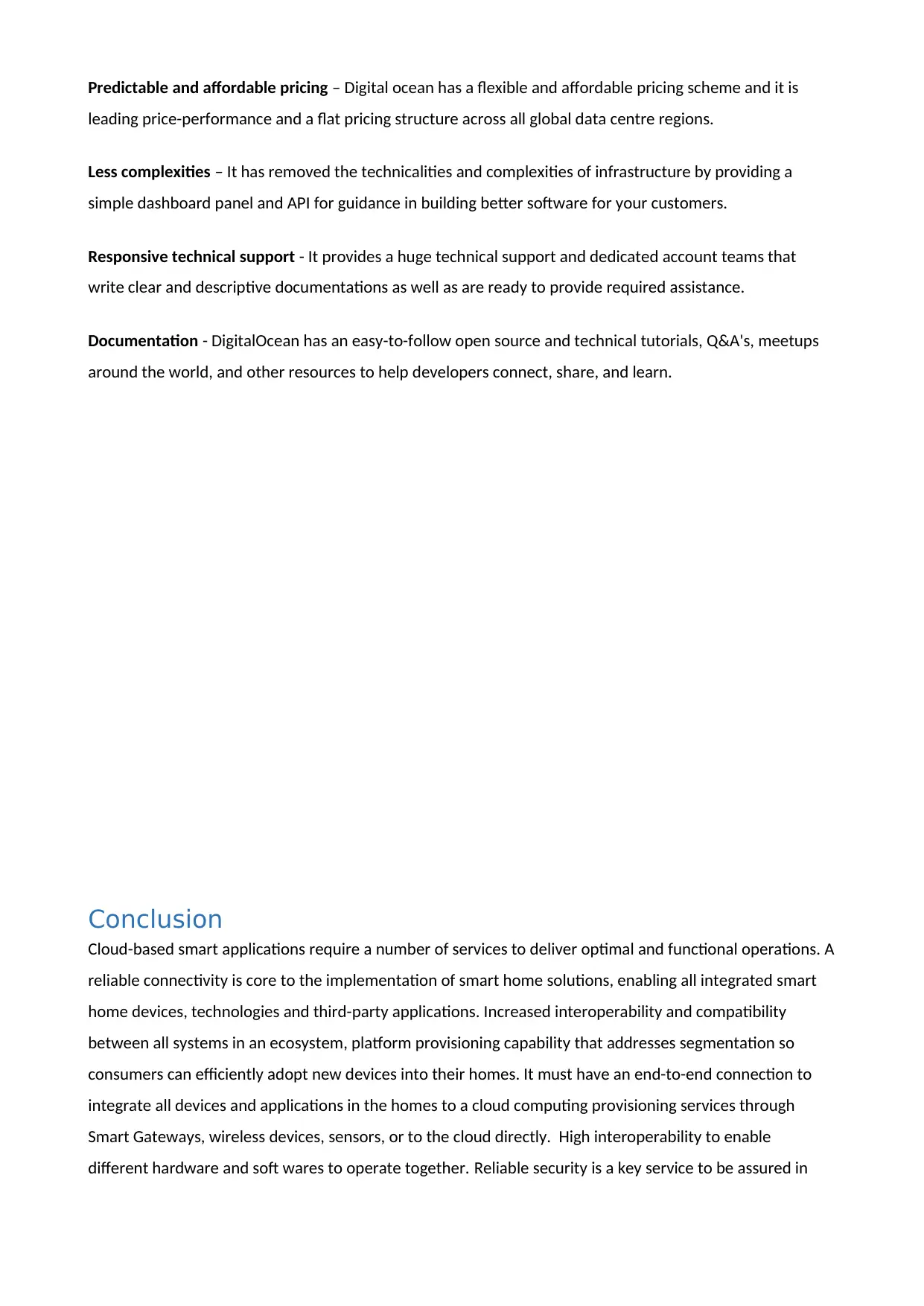
Predictable and affordable pricing – Digital ocean has a flexible and affordable pricing scheme and it is
leading price-performance and a flat pricing structure across all global data centre regions.
Less complexities – It has removed the technicalities and complexities of infrastructure by providing a
simple dashboard panel and API for guidance in building better software for your customers.
Responsive technical support - It provides a huge technical support and dedicated account teams that
write clear and descriptive documentations as well as are ready to provide required assistance.
Documentation - DigitalOcean has an easy-to-follow open source and technical tutorials, Q&A's, meetups
around the world, and other resources to help developers connect, share, and learn.
Conclusion
Cloud-based smart applications require a number of services to deliver optimal and functional operations. A
reliable connectivity is core to the implementation of smart home solutions, enabling all integrated smart
home devices, technologies and third-party applications. Increased interoperability and compatibility
between all systems in an ecosystem, platform provisioning capability that addresses segmentation so
consumers can efficiently adopt new devices into their homes. It must have an end-to-end connection to
integrate all devices and applications in the homes to a cloud computing provisioning services through
Smart Gateways, wireless devices, sensors, or to the cloud directly. High interoperability to enable
different hardware and soft wares to operate together. Reliable security is a key service to be assured in
leading price-performance and a flat pricing structure across all global data centre regions.
Less complexities – It has removed the technicalities and complexities of infrastructure by providing a
simple dashboard panel and API for guidance in building better software for your customers.
Responsive technical support - It provides a huge technical support and dedicated account teams that
write clear and descriptive documentations as well as are ready to provide required assistance.
Documentation - DigitalOcean has an easy-to-follow open source and technical tutorials, Q&A's, meetups
around the world, and other resources to help developers connect, share, and learn.
Conclusion
Cloud-based smart applications require a number of services to deliver optimal and functional operations. A
reliable connectivity is core to the implementation of smart home solutions, enabling all integrated smart
home devices, technologies and third-party applications. Increased interoperability and compatibility
between all systems in an ecosystem, platform provisioning capability that addresses segmentation so
consumers can efficiently adopt new devices into their homes. It must have an end-to-end connection to
integrate all devices and applications in the homes to a cloud computing provisioning services through
Smart Gateways, wireless devices, sensors, or to the cloud directly. High interoperability to enable
different hardware and soft wares to operate together. Reliable security is a key service to be assured in
Secure Best Marks with AI Grader
Need help grading? Try our AI Grader for instant feedback on your assignments.

smart application through the provision of theft deterrence, malware detection, and advanced
authorization and authentication features.
References
[1] A. Colangelo, “Introduction to Cloud Computing,” CloudAcademy, 2018. [Online]. Available:
Introduction to Cloud Computing.
[2] Dialogic, “Introduction to Cloud Computing,” p. 9, 2017.
[3] Y.-T. Lee, W.-H. Hsiao, C.-M. Huang and S.-C. T. Chou, “An Integrated Cloud-Based Smart Home
authorization and authentication features.
References
[1] A. Colangelo, “Introduction to Cloud Computing,” CloudAcademy, 2018. [Online]. Available:
Introduction to Cloud Computing.
[2] Dialogic, “Introduction to Cloud Computing,” p. 9, 2017.
[3] Y.-T. Lee, W.-H. Hsiao, C.-M. Huang and S.-C. T. Chou, “An Integrated Cloud-Based Smart Home
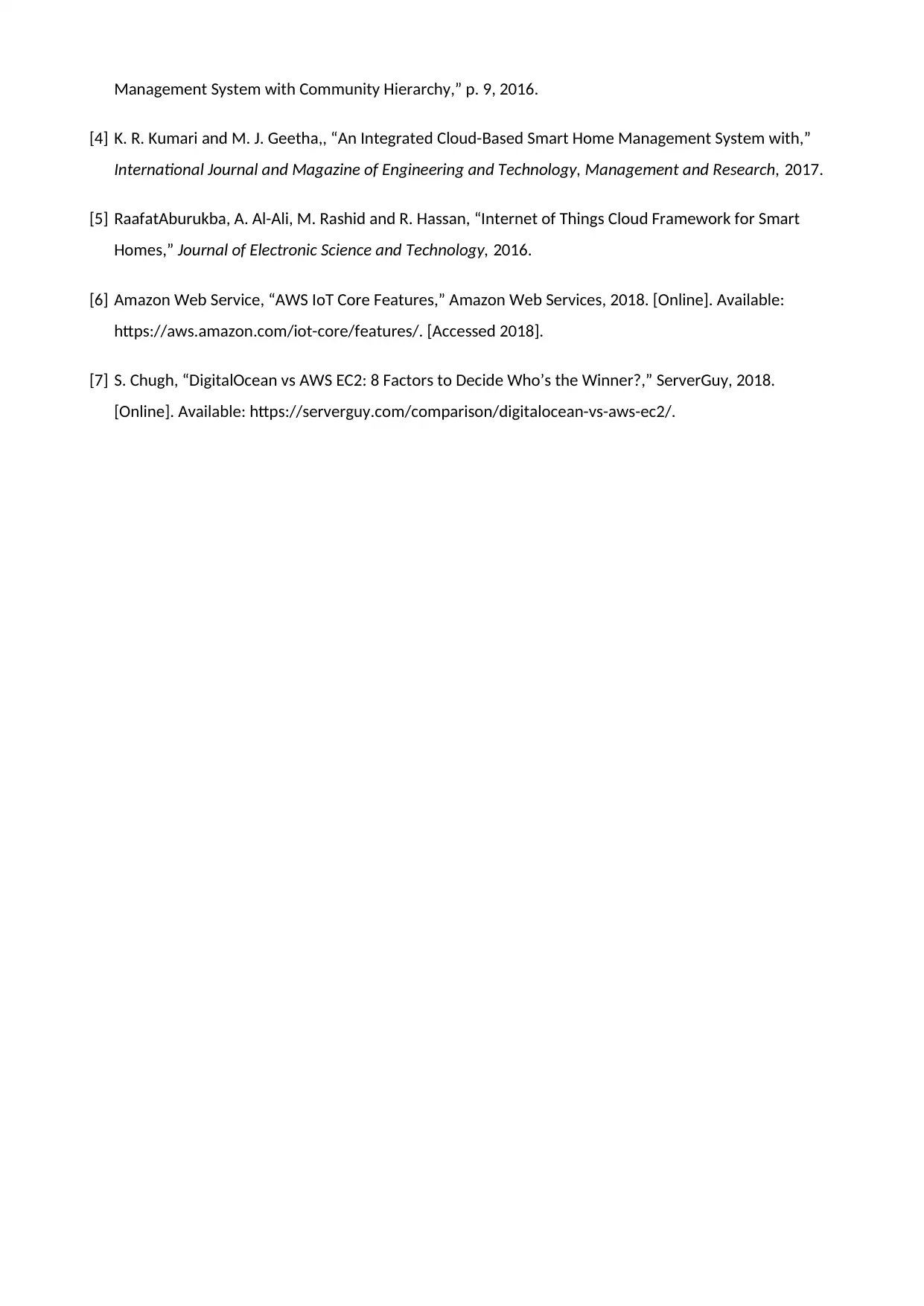
Management System with Community Hierarchy,” p. 9, 2016.
[4] K. R. Kumari and M. J. Geetha,, “An Integrated Cloud-Based Smart Home Management System with,”
International Journal and Magazine of Engineering and Technology, Management and Research, 2017.
[5] RaafatAburukba, A. Al-Ali, M. Rashid and R. Hassan, “Internet of Things Cloud Framework for Smart
Homes,” Journal of Electronic Science and Technology, 2016.
[6] Amazon Web Service, “AWS IoT Core Features,” Amazon Web Services, 2018. [Online]. Available:
https://aws.amazon.com/iot-core/features/. [Accessed 2018].
[7] S. Chugh, “DigitalOcean vs AWS EC2: 8 Factors to Decide Who’s the Winner?,” ServerGuy, 2018.
[Online]. Available: https://serverguy.com/comparison/digitalocean-vs-aws-ec2/.
[4] K. R. Kumari and M. J. Geetha,, “An Integrated Cloud-Based Smart Home Management System with,”
International Journal and Magazine of Engineering and Technology, Management and Research, 2017.
[5] RaafatAburukba, A. Al-Ali, M. Rashid and R. Hassan, “Internet of Things Cloud Framework for Smart
Homes,” Journal of Electronic Science and Technology, 2016.
[6] Amazon Web Service, “AWS IoT Core Features,” Amazon Web Services, 2018. [Online]. Available:
https://aws.amazon.com/iot-core/features/. [Accessed 2018].
[7] S. Chugh, “DigitalOcean vs AWS EC2: 8 Factors to Decide Who’s the Winner?,” ServerGuy, 2018.
[Online]. Available: https://serverguy.com/comparison/digitalocean-vs-aws-ec2/.
1 out of 12
Related Documents
Your All-in-One AI-Powered Toolkit for Academic Success.
+13062052269
info@desklib.com
Available 24*7 on WhatsApp / Email
![[object Object]](/_next/static/media/star-bottom.7253800d.svg)
Unlock your academic potential
© 2024 | Zucol Services PVT LTD | All rights reserved.





